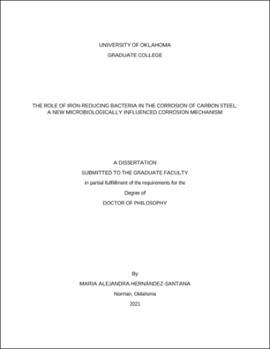| dc.description.abstract | It was not too long ago that the ability of microorganisms to capture energy by engaging in electron transfer reactions with extracellular solid materials was discovered. This discovery has shifted the paradigms regarding the requirements for life and has prompted tremendous research interest in the challenges and opportunities this type of metabolism poses for humankind. Possibly, in no other field does the microbial extracellular electron transfer reactions have more direct implications today than in the corrosion of steel infrastructure. Due to the strong dependence of our society on iron and its alloys, understanding how microorganisms influence the corrosion of these materials through extracellular electron transfer reactions becomes a matter of substantial importance for industries across the globe. In this dissertation, I aimed to answer how the iron-reducing bacterium Shewanella oneidensis influences the corrosion of carbon steel. It was in this organism where researchers witnessed for the first time the ability of microorganisms to transfer electrons to extracellular substrates, and since then, S. oneidensis has become a model for the understanding of microbial extracellular electron transfer reactions. Because Shewanella spp. are also frequently found in steel infrastructure undergoing corrosion, the next logical question to address is whether or not Shewanella spp. could use extracellular electron uptake to accelerate the corrosion of steel. Addressing the aforementioned questions was the goal in the making of this dissertation.
In Chapter 1, I will introduce my motivation to pursue these fascinating research questions, present my hypotheses and goals, and provide a literature review on the ecophysiology of the genus Shewanella, our current understanding of the microbiologically influenced corrosion of steel, and the existing knowledge on the role that iron-reducing bacteria play in the corrosion of carbon steel.
In Chapter 2, I evaluate the ability of S. oneidensis to accelerate the corrosion of carbon steel by removing the iron oxide passivating layer through dissimilatory iron reduction, and I test the hypothesis that the presence of short-chain deprotonated dicarboxylic acids would exacerbate corrosion driven by S. oneidensis by accelerating the dissolution of ferric iron and increasing the microbial iron respiration rates. I found that the short-chain deprotonated dicarboxylic acids oxalate, malonate, and succinate accelerate the corrosion of carbon steel driven by S. oneidensis up to 2.6 times more relative to the sterile control experiment without dicarboxylates. The three deprotonated dicarboxylic acids tested enhanced the dissolution of ferric iron, but interestingly this did not result in increased iron respiration rates. My results suggest that a complex array of competing biological (e.g., microbial iron reduction), chemical (e.g., ligand-assisted iron dissolution), and physical (e.g., adsorption of corrosion products) processes drive the accelerated corrosion of carbon steel by iron-reducing bacteria in the presence of iron-binding ligands.
In Chapter 3, I offer a novel approach to test the ability of microorganisms to take electrons directly from carbon steel while evaluating the role of hydrogen consumption metabolism and direct electron uptake in the corrosion of carbon steel driven by S. oneidensis. I performed experiments with carbon steel and a S. oneidensis strain incapable of consuming hydrogen and a strain incapable of engaging in direct electron uptake. The results showed that S. oneidensis accelerates the corrosion of carbon steel up to four times more when compared to abiotic experiments and that direct electron uptake is the most significant corrosion mechanism in S. oneidensis.
Finally, in Chapter 4, I offer my insights on the new research questions that emerge based on the findings of this dissertation and provide my ideas on the contributions and the limitations of my Ph.D. research. | en_US |

